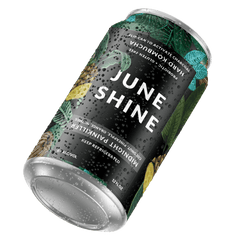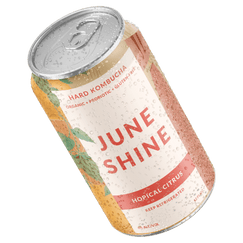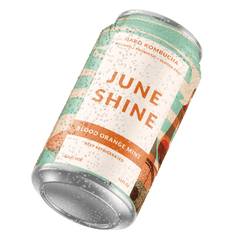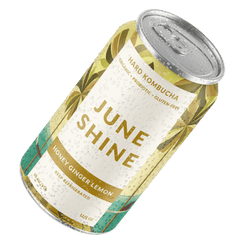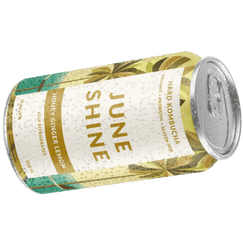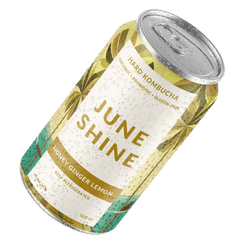Fermentation: The Making Of Kombucha

Fermentation: The Making Of Kombucha
We’ve said it before, and we’ll say it again: kombucha is it. This fermented tea is a fave among health and fitness junkies, thanks to the massive number of health benefits you can get.
Kombucha’s unique tart taste has people swigging it in droves, too. It really does stand on its own. For fans of tart, bittersweet profiles, this is the beverage for you.
Tart, refreshing, and perfectly fizzy; once you go booch, there’s no going back.
What really sets kombucha apart is the way that it’s produced, which is where it gets those health-enhancing attributes. Interested in learning more about it? Here’s the SparkNotes version:
Kombucha goes through a chemical breakdown known as fermentation, where enzymes break down molecules like glucose. This process is also what leads to delicious fermented foods like yogurt, sauerkraut, and sourdough bread, as well as boozy drinks like wine (which, if you didn’t know, is literally fermented grape juice). In case you couldn’t tell, we’re pretty big fans of fermentation.
When creating kombucha, yeast and bacteria are isolated with tea leaves. These three icons interact and naturally start making carbon dioxide and ethanol in the absence of oxygen.
The alcohol content (you know, the fun stuff) of kombucha comes from this ethanol. If you’ve ever had kombucha, you probably already know that it’s slightly alcoholic. If you haven’t, well, we’re about to introduce you to something even better, but hold on that. The average kombucha contains around 0.5% ABV. It’s not enough to get you buzzed, but it is enough to taste a difference!
If we haven’t already bored you to tears with the middle school science talk, we’re going to teach you exactly how this trendy tea is made. Spoiler alert: you might think it’s easy, but kombucha is one thing that you’re definitely going to want to be purchasing already made.
Most people don’t want to go through the hassle of making their own kombucha—it’s time-consuming, complicated, and there’s a way easier alternative. Enter JuneShine, the hard kombucha that’s going to change your life (and also teach you everything you never wanted to know about fermentation).
Here’s the Tea on Fermentation
Fermentation plays a huge role in biochemistry, so we could sit here and throw a whole bunch of chemistry-sounding words at you like glycolysis and lactic acid fermentation. Did that sound like a sneeze to you? Because it sounded like one to us.
You just want to know where delicious foods and drinks like kimchi, pickles, kefir, and other yummy fermented vegetables—and mostly kombucha—come from.
Fermentation actually goes way back. Louis Pasteur, the guy who invented pasteurization, basically showed that fermentation is due to living organisms, but people were using it to prevent food spoilage long before that.
All alcohol is a derivative of fermentation, so that goes all the way back to around 7000 BCE, and people were turning dairy products into yogurt starting in the Neolithic period. Ah, drawing on cave walls, running from saber-toothed tigers, and getting our daily probiotics in. Nothing better.
How’s Kombucha Made? The Fast Answer
It’s time to put on your lab coat and pretend that you’re in Dexter’s Lab—or at least know that you’re getting yourself into a pretty detailed convo about making kombucha.
For our precious kombucha to come to life, a very particular blend of materials is used called SCOBY (a symbiotic colony of bacteria and yeast, not a cowardly dog that rides around in a psychedelic van). Producers can use pre-made SCOBY kits or create their own. If that seems like a lot of work, you’d be right.
Usually, green or black tea leaves get to work with the SCOBY, but white and oolong can guest-star, too. The type of tea used will significantly affect the final taste of the kombucha, but we love ‘em all.
The blend is fermented two separate times to extract the highest possible amount of microbes—double trouble, baby. It’s during the fermentation process, the taste, texture, alcohol content, and caffeine content are established.
The first fermentation infuses the drink with probiotics, thanks to our best pal, the SCOBY. For the second fermentation, the SCOBY and the kombucha part ways, but some new friends show up in the form of fruit, herbs, and spices that may be added for extra flavor.
A typical ingredient list for a batch of kombucha looks something like this:
- Three quarts of purified water with no chlorine
- A cup of sugar, four to six tea bags or four to six tablespoons of loose leaf tea
- One to two cups of base liquid
- SCOBY
When the kombucha is done fermenting, it’s strained through a cheesecloth into a clean, air-tight bottle, usually made of glass. Sometimes, fruit, juice, flowers, or herbs can be placed inside the bottle for flavoring and/or because they look cute. Could be either.
Afterward, the bottle is stored at room temperature for one to three days, being burped (yes, like a baby) periodically to release carbonation. Once the kombucha is perf, you can put it in the fridge.
Does that sound like a lot of work? This was just the basic version, and we’re not even done yet.
How Is Kombucha Made? The Long Answer
Making the SCOBY
The best kombucha is made by producers that make their own SCOBY (hey, how ya doin? Meet JuneShine).
The first step of creating this yeast bacteria blend is to boil water and add sugar. After that, the tea is steeped until the blend comes down to room temperature. This usually takes a few hours.
The tea used for this process is always caffeinated, as decaffeinated teas and fruit teas just don’t have the oomph that SCOBY is looking for.
Once the water is at room temperature, the mixture is poured into a jar and mixed with live probiotics.
It’s stored in a dark setting at room temperature for between one and four weeks. By then, about a quarter-inch of SCOBY will have formed. It looks just as weird as it sounds, guys.
If treated properly, the SCOBY can live and continue to vibe for years. Remember, this is essentially a community of living microorganisms, so they need a home that’s nice to live in!
Fermentation Nation: Take One
Once the SCOBY is ready to go, it’s time to ferment.
The initial fermentation should include lots of clean water, a healthy dose of black tea leaves, a few cups of unpasteurized, unflavored kombucha, some white sugar, and SCOBY.
Water is brought to a boil in a clean pot (because why would you use a dirty one?). It’s removed from the heat and then sugar and tea are added. Let it sit until it cools down.
This tea is then poured into a fresh jar, along with the unflavored kombucha. Next, the SCOBY is mixed in.
The jar is covered tightly with cloth and a rubber band. It’s stored in a dark place at room temperature for six to ten days. The warmer the environment is, the faster the fermenting process is.
After six days, the producer can begin tasting the tea by using a paper straw. At this point, the tea should be slightly sweet and a bit vinegary. The longer it’s left to ferment, the more sugar will be eaten up by the SCOBY, and the less sweet it’ll be.
Fermentation Nation: Take Two
When the first fermentation has concluded, a few cups of the mixture are removed to use in the next batch. The rest of the blend moves on to the second fermentation.
It’s time for the fun part because now, producers have a lot more freedom in their ingredients.
If a kombucha maker wants to mix in another kind of tea? Go off! Fruit tea can help feed the SCOBY and add a touch of sweetness.
Want to make something crazy? Add fruit, juice, herbs, spices, seeds, candies—almost anything.
This second fermentation goes for two to ten days in the dark at room temperature. Once the producer is satisfied with its taste, they open the bottle gently with a towel, just in case it gets a little rowdy.
The drink can be placed in the fridge to slow down the carbonation process. Phew! That was a lot of work, and we think we all deserve a cold, refreshing drink—how about a can of JuneShine?
You Can Try This At Home, But Why Would You Want To?
Before you run off and try to make your own kombucha at home, take a sec to really think about the risks.
When you’re working with bacteria, it’s super easy for stuff to go wrong. If you’re not careful about sterilizing all your equipment (not just cleaning with soap and water, people), you risk totally wrecking your booch and even making yourself sick. No thanks.
For these reasons, most people choose to just buy kombucha in stores or online. Not only is it way, way easier, but it also tastes better—people like us are professionals for a reason, and it’s because we’ve worked on our craft.
Plus, with JuneShine, you get that fun extra kick. What’s not to love?
Packed With Probiotics
Without the process of fermentation, kombucha wouldn’t be the sensation it is today, because that’s where we’re getting all those awesome probiotics.
Probiotics are live microorganisms that are naturally produced in the body and found in many different foods. Kombucha has some essential probiotics that can lend you a hand with your gut health and digestion.
Kombucha is also packed with a bunch of vitamin B, which has been shown to improve energy and focus. Combined with its small dose of caffeine, this makes kombucha a great morning drink… Or lunchtime, or early afternoon, or evening… Okay, we’ll stop. Basically, kombucha works anywhere, anytime.
Let the Fermentation Magic Begin
Fermentation is no joke! Most of us don’t want to take on this adventure, which is why it’s so great that we’ve already done the hard part for you.
Along with its many health benefits, kombucha is simply mouthwatering. And when you add the little extra pizazz that JuneShine is known for (hint: it’s 6%), you’ll think you’ve gone to beverage heaven. If you haven’t tried it yet, what are you waiting for?
Sources:
The Earliest Alcoholic Beverage in the World | Penn Research
Fermentation - an overview | Science Direct
Louis Pasteur - Inventions, Achievements & Facts | Biography
